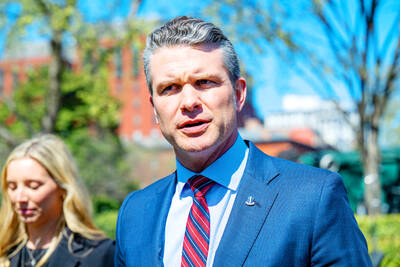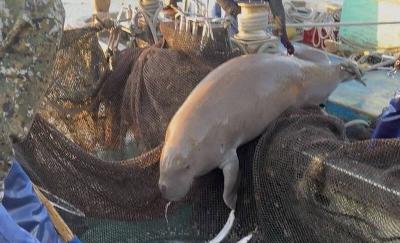The Taipei-Yilan Highway has been voted Taiwan’s most-haunted site in an online survey of the nation’s top 10 haunted places conducted by Internet portal Yam.com.
The winding mountain road, which runs from New Taipei City’s Xindian District (新店) to Yilan County — also known as Provincial Highway No. 9 — has many hairpin turns. It has been dubbed the “Highway of Death,” because of the many fatal accidents that have happened on it. In recent years, traffic on the road has declined considerably with the opening of the Hsuehshan Tunnel and the Chiang Wei-shui Memorial Freeway (Freeway No. 5) in June 2006.
Some motorists have reported seeing ghostly apparitions, human-like figures shrouded in white floating through the air, while driving the mountainous area.
Drivers have been warned against speaking to or picking up female hitchhikers at night on the road, as there are a number of tales about such incidents having scary endings.
Yilan County Councilor Tsai Wen-yi (蔡文益) said the Taipei-Yilan Highway has seen reduced traffic and fewer accidents since the Hsuehshan Tunnel began operating in 2006.
“A program was implemented to widen the road and it was made more beautiful with landscaping works. Thus it is now more suited for leisure and tourism. The ghost stories are from the past and have no connection to the road’s new look,” Tsai said.
No. 2 on the online poll is Greater Taichung’s Port Road, the site of the Wellcome Restaurant blaze in 1995 that resulted in 64 deaths. It is the worst fire disaster in the nation’s history.
Locals claim to have seen a “ghost ship” appearing over the site late at night, with anecdotes saying the phantom ship will only set sail after it has gathered 100 souls.
Though two decades have passed, some locals say they are still scared when the restaurant and the fire are mentioned.
Greater Taichung City Councilor Huang Kuo-shu (黃國書) said the location was once a lively business section in the city, “but since the fire, the area has declined considerably.”
“We would like to revitalize the neighborhood,” Huang said.
It has been two decades since the fire and most people have forgotten about it, unless they are old residents in the area, he added.
Huang said the area has the just-launched Taichung rapid bus route passing through it with a stop nearby, as well as new hotels and stores opening, and the locals are happy to see signs of rejuvenation.
“Things are coming back to life, but now that it has come up in this list of haunted places. People in the area feel frustrated,” he said.
Taipei’s Xinhai Tunnel is No. 3 on the list. The location is a rich source of ghost stories, with scary experiences claimed by motorists passing through it late at night. The tunnel passes under an old graveyard, and the Taipei Municipal Second Funeral Parlor is at the Taipei-side entrance.
Other places on the list include Dayuan Township (大園) in Taoyuan County (the site of crash of China Airlines Flight 676 in 1998), Ita-Thao Harbor at Sun Moon Lake, an abandoned hospital in Greater Tainan, Daren Hall at the Chinese Culture University, a house in Chiayi County’s Mingsyong Township (民雄) that is said to be haunted, Taipei’s Sining Public Housing Apartments and Meichi Night Club in Keelung, which is said to be haunted.
Yam.com said the online poll took place between July 11 and Friday, and received 40,000 votes.
The seventh month of the lunar calendar is traditionally known as Ghost Month, and it began yesterday.
Taiwanese traditionally believe that during Ghost Month, the door to the underworld opens so that the spirits of the dead can come back to the world and partake of food offerings prepared by family members.

‘DENIAL DEFENSE’: The US would increase its military presence with uncrewed ships, and submarines, while boosting defense in the Indo-Pacific, a Pete Hegseth memo said The US is reorienting its military strategy to focus primarily on deterring a potential Chinese invasion of Taiwan, a memo signed by US Secretary of Defense Pete Hegseth showed. The memo also called on Taiwan to increase its defense spending. The document, known as the “Interim National Defense Strategic Guidance,” was distributed this month and detailed the national defense plans of US President Donald Trump’s administration, an article in the Washington Post said on Saturday. It outlines how the US can prepare for a potential war with China and defend itself from threats in the “near abroad,” including Greenland and the Panama

The High Prosecutors’ Office yesterday withdrew an appeal against the acquittal of a former bank manager 22 years after his death, marking Taiwan’s first instance of prosecutors rendering posthumous justice to a wrongfully convicted defendant. Chu Ching-en (諸慶恩) — formerly a manager at the Taipei branch of BNP Paribas — was in 1999 accused by Weng Mao-chung (翁茂鍾), then-president of Chia Her Industrial Co, of forging a request for a fixed deposit of US$10 million by I-Hwa Industrial Co, a subsidiary of Chia Her, which was used as collateral. Chu was ruled not guilty in the first trial, but was found guilty

A wild live dugong was found in Taiwan for the first time in 88 years, after it was accidentally caught by a fisher’s net on Tuesday in Yilan County’s Fenniaolin (粉鳥林). This is the first sighting of the species in Taiwan since 1937, having already been considered “extinct” in the country and considered as “vulnerable” by the International Union for Conservation of Nature. A fisher surnamed Chen (陳) went to Fenniaolin to collect the fish in his netting, but instead caught a 3m long, 500kg dugong. The fisher released the animal back into the wild, not realizing it was an endangered species at

DEADLOCK: As the commission is unable to forum a quorum to review license renewal applications, the channel operators are not at fault and can air past their license date The National Communications Commission (NCC) yesterday said that the Public Television Service (PTS) and 36 other television and radio broadcasters could continue airing, despite the commission’s inability to meet a quorum to review their license renewal applications. The licenses of PTS and the other channels are set to expire between this month and June. The National Communications Commission Organization Act (國家通訊傳播委員會組織法) stipulates that the commission must meet the mandated quorum of four to hold a valid meeting. The seven-member commission currently has only three commissioners. “We have informed the channel operators of the progress we have made in reviewing their license renewal applications, and